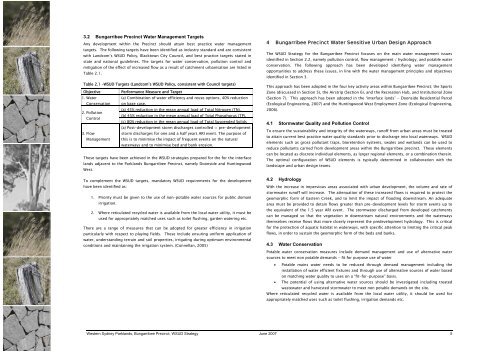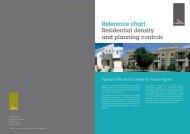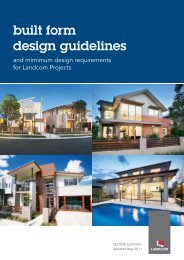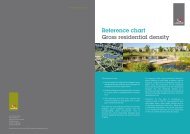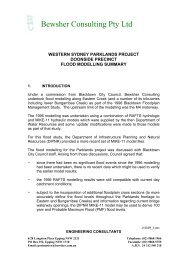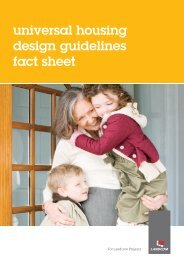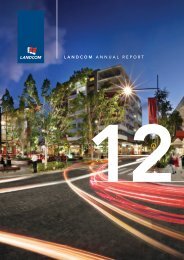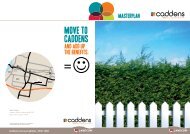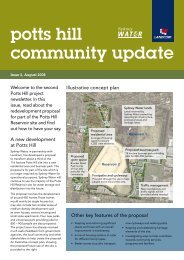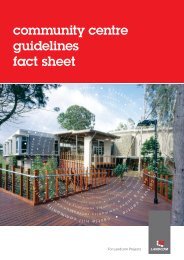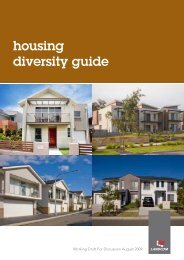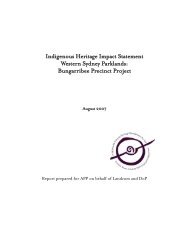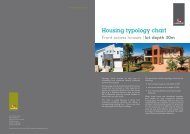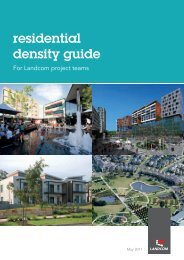WSUD Strategy
Parklands Bungarribee Precinct | WsUD Strategy Report - Landcom
Parklands Bungarribee Precinct | WsUD Strategy Report - Landcom
- No tags were found...
You also want an ePaper? Increase the reach of your titles
YUMPU automatically turns print PDFs into web optimized ePapers that Google loves.
3.2 Bungarribee Precinct Water Management Targets<br />
Any development within the Precinct should attain best practice water management<br />
targets. The following targets have been identified as industry standard and are consistent<br />
with Landcom’s <strong>WSUD</strong> Policy, Blacktown City Council, and best practice targets stated in<br />
state and national guidelines. The targets for water conservation, pollution control and<br />
mitigation of the effect of increased flow as a result of catchment urbanisation are listed in<br />
Table 2.1.<br />
Table 2.1 –<strong>WSUD</strong> Targets (Landcom’s <strong>WSUD</strong> Policy, consistent with Council targets)<br />
Objective<br />
Performance Measure and Target<br />
1. Water<br />
(a) Combination of water efficiency and reuse options, 40% reduction<br />
Conservation on base case.<br />
(a) 45% reduction in the mean annual load of Total Nitrogen (TN).<br />
2. Pollution<br />
(b) 45% reduction in the mean annual load of Total Phosphorus (TP).<br />
Control<br />
(c) 80% reduction in the mean annual load of Total Suspended Solids<br />
(a) Post-development storm discharges controlled = pre-development<br />
3. Flow<br />
storm discharges for one and a half years ARI event. The purpose of<br />
Management this is to minimise the impact of frequent events on the natural<br />
waterways and to minimise bed and bank erosion.<br />
These targets have been achieved in the <strong>WSUD</strong> strategies prepared for the for the interface<br />
lands adjacent to the Parklands Bungarribee Precinct, namely Doonside and Huntingwood<br />
West.<br />
To complement the <strong>WSUD</strong> targets, mandatory <strong>WSUD</strong> requirements for the development<br />
have been identified as:<br />
1. Priority must be given to the use of non-potable water sources for public domain<br />
irrigation.<br />
2. Where reticulated recycled water is available from the local water utility, it must be<br />
used for appropriately matched uses such as toilet flushing, garden watering etc.<br />
There are a range of measures that can be adopted for greater efficiency in irrigation<br />
particularly with respect to playing fields. These include ensuring uniform application of<br />
water, understanding terrain and soil properties, irrigating during optimum environmental<br />
conditions and maintaining the irrigation system. (Connellan, 2005)<br />
4 Bungarribee Precinct Water Sensitive Urban Design Approach<br />
The <strong>WSUD</strong> <strong>Strategy</strong> for the Bungarribee Precinct focuses on the main water management issues<br />
identified in Section 2.2, namely pollution control, flow management / hydrology, and potable water<br />
conservation. The following approach has been developed identifying water management<br />
opportunities to address these issues, in line with the water management principles and objectives<br />
identified in Section 3.<br />
This approach has been adopted in the four key activity areas within Bungarribee Precinct; the Sports<br />
Zone (discussed in Section 5), the Airstrip (Section 6), and the Recreation Hub, and Institutional Zone<br />
(Section 7). This approach has been adopted in the ‘interface lands’ - Doonside Residential Parcel<br />
(Ecological Engineering, 2007) and the Huntingwood West Employment Zone (Ecological Engineering,<br />
2006).<br />
4.1 Stormwater Quality and Pollution Control<br />
To ensure the sustainability and integrity of the waterways, runoff from urban areas must be treated<br />
to attain current best practice water quality standards prior to discharge into local waterways. <strong>WSUD</strong><br />
elements such as gross pollutant traps, bioretention systems, swales and wetlands can be used to<br />
reduce pollutants carried from development areas within the Bungarribee precinct. These elements<br />
can be located as discrete individual elements, as larger regional elements, or a combination therein.<br />
The optimal configuration of <strong>WSUD</strong> elements is typically determined in collaboration with the<br />
landscape and urban design teams.<br />
4.2 Hydrology<br />
With the increase in impervious areas associated with urban development, the volume and rate of<br />
stormwater runoff will increase. The attenuation of these increased flows is required to protect the<br />
geomorphic form of Eastern Creek, and to limit the impact of flooding downstream. An adequate<br />
area must be provided to detain flows greater than pre-development levels for storm events up to<br />
the equivalent of the 1.5 year ARI event. The stormwater discharged from developed catchments<br />
can be managed so that the vegetation in downstream natural environments and the waterways<br />
themselves receive flows that more closely represent the predevelopment hydrology. This is critical<br />
for the protection of aquatic habitat in waterways, with specific attention to limiting the critical peak<br />
flows, in order to sustain the geomorphic form of the beds and banks.<br />
4.3 Water Conservation<br />
Potable water conservation measures include demand management and use of alternative water<br />
sources to meet non potable demands - fit for purpose use of water<br />
• Potable mains water needs to be reduced through demand management including the<br />
installation of water efficient fixtures and through use of alternative sources of water based<br />
on matching water quality to uses on a “fit-for-purpose” basis.<br />
• The potential of using alternative water sources should be investigated including treated<br />
wastewater and harvested stormwater to meet non potable demands on the site.<br />
Where reticulated recycled water is available from the local water utility, it should be used for<br />
appropriately matched uses such as toilet flushing, irrigation demands etc.<br />
Western Sydney Parklands, Bungarribee Precinct, <strong>WSUD</strong> <strong>Strategy</strong> June 2007 5


